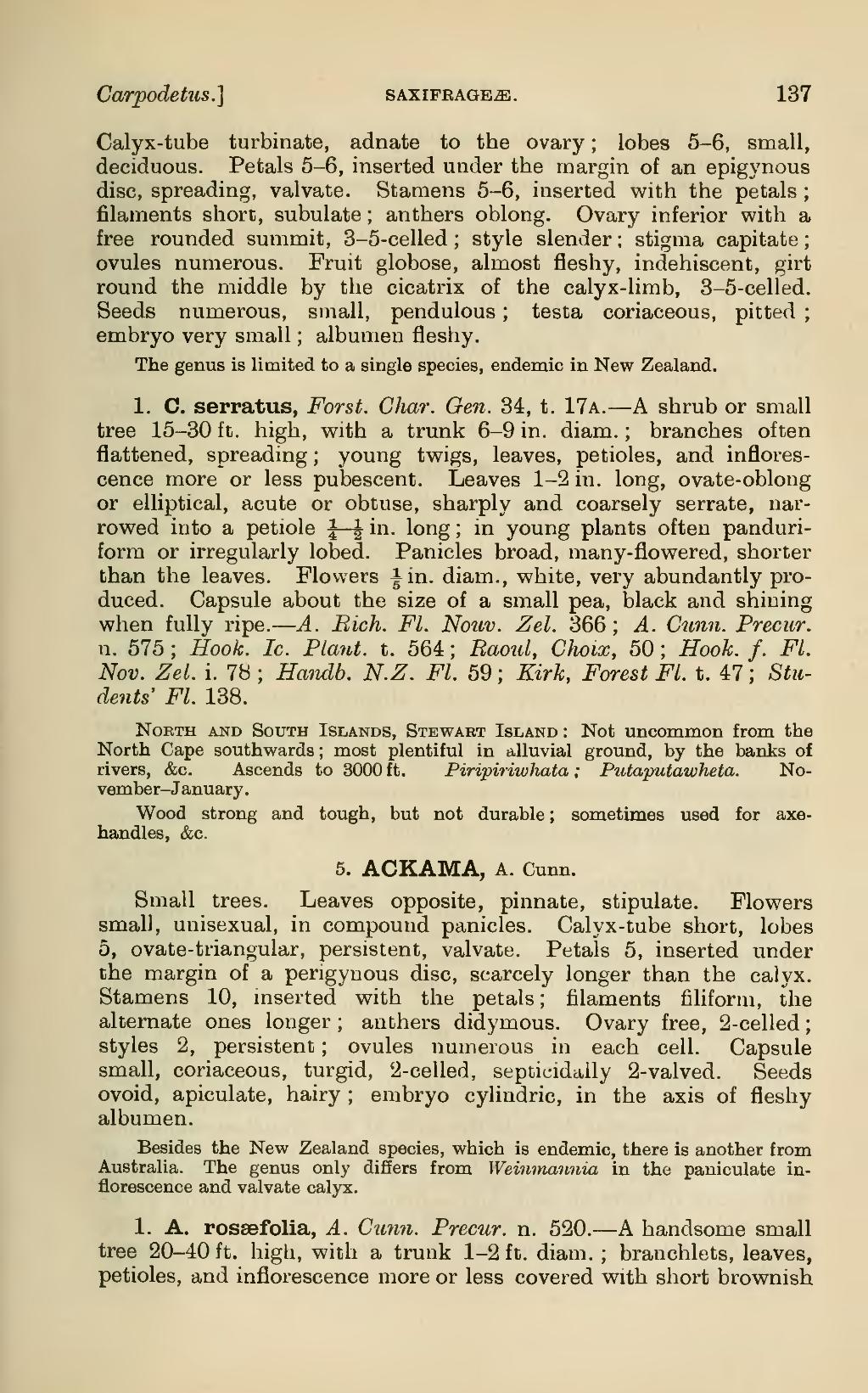Calyx-tube turbinate, adnate to the ovary; lobes 5–6, small, deciduous. Petals 5–6, inserted under the margin of an epigynous disc, spreading, valvate. Stamens 5–6, inserted with the petals; filaments shore, subulate; anthers oblong. Ovary inferior with a free rounded summit, 3–5-celled; style slender; stigma capitate; ovules numerous. Fruit globose, almost fleshy, indehiscent, girt round the middle by the cicatrix of the calyx-limb, 3–5-celled. Seeds numerous, small, pendulous; testa coriaceous, pitted; embryo very small; albumen fleshy.
The genus is limited to a single species, endemic in New Zealand.
1. C. serratus, Forst. Char. Gen. 34, t. 17a.—A shrub or small tree 15–30 ft. high, with a trunk 6–9 in. diam.; branches often flattened, spreading; young twigs, leaves, petioles, and inflorescence more or less pubescent. Leaves 1–2 in. long, ovate-oblong or elliptical, acute or obtuse, sharply and coarsely serrate, narrowed into a petiole ¼–½ in. long; in young plants often panduriform or irregularly lobed. Panicles broad, many-flowered, shorter than the leaves. Flowers 15 in. diam., white, very abundantly produced. Capsule about the size of a small pea, black and shining when fully ripe.—A. Rich. Fl. Nouv. Zel. 366; A. Cunn. Precur. n. 575; Hook. Ic. Plant, t. 564; Raoul, Choix, 50; Hook. f. Fl. Nov. Zel. i. 78; Handb. N.Z. Fl. 59; Kirk, Forest Fl. t. 47; Students' Fl. 138.
North and South Islands, Stewart Island: Not uncommon from the North Cape southwards; most plentiful in alluvial ground, by the banks of rivers, &c. Ascends to 3000 ft. Piripiriwhata; Putaputawheta. November–January.
Wood strong and tough, but not durable; sometimes used for axe-handles, &c.
5. ACKAMA, A. Cunn.
Small trees. Leaves opposite, pinnate, stipulate. Flowers small, unisexual, in compound panicles. Calyx-tube short, lobes 5, ovate-triangular, persistent, valvate. Petals 5, inserted under the margin of a perigynous disc, scarcely longer than the calyx. Stamens 10, inserted with the petals; filaments filiform, the alternate ones longer; anthers didymous. Ovary free, 2-celled; styles 2, persistent; ovules numerous in each cell. Capsule small, coriaceous, turgid, 2-celled, septicidally 2-valved. Seeds ovoid, apiculate, hairy; embryo cylindric, in the axis of fleshy albumen.
Besides the New Zealand species, which is endemic, there is another from Australia. The genus only differs from Weinmannia in the paniculate inflorescence and valvate calyx.
1. A. rosæfolia, A. Cunn. Precur. n. 520.—A handsome small tree 20–40 ft. high, with a trunk 1–2 ft. diam.; branchlets, leaves, petioles, and inflorescence more or less covered with short brownish
